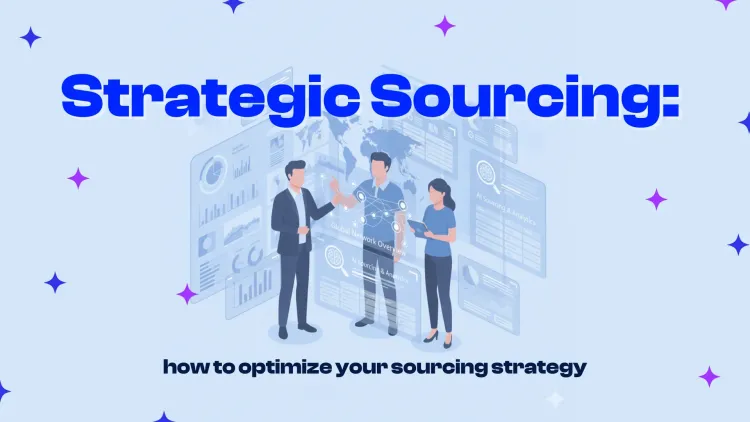5 mistakes slowing down sourcing (that hardly anyone sees)
4/9/2025
•3 MIN READ
Procurement teams often don’t realize that some seemingly harmless activities silently undermine operational efficiency and final results. The most common issues include poor cost visibility, manual processes, and the absence of data-driven analysis (McKinsey & Company, 2025).
Here are the five hidden mistakes that most often slow down sourcing:
1. Superficial supplier selection Suppliers are often chosen based on speed or immediate availability rather than true qualifications. This leads to delays, poor quality, or unreliable partners.
2. Hidden spending: invisible waste Without a unified view of spend, the risk of duplicate orders, budget overruns, or policy violations increases significantly.
3. Paper-based or manual processes Relying on Excel, emails, and manual approvals creates friction: delays, errors, and dispersed documentation — all costly inefficiencies.
4. Ignoring total cost of ownership (TCO) A low unit price can be misleading. Transportation, support, quality, and warranties all impact the real cost.
5. Outdated supplier data Incomplete or obsolete supplier databases result in missed opportunities and repeated cycles of ineffective sourcing.
These mistakes weigh heavily on procurement departments and organizations as a whole. In fact, studies cited by Wired and the book Bad Buying show that over 90% of procurement projects fail at the very first stage due to poor visibility, inconsistent analysis, and shallow supplier selection — generating massive waste on a global scale (Economist Impact, 2025).
To avoid falling into these traps, it’s essential to:
- Centralize information on spend and purchasing methods
- Use structured scorecards to evaluate suppliers
- Automate critical workflows such as sourcing, RFX, and supplier response analysis
- Always include total cost of ownership in evaluations
- Keep supplier databases updated with certifications, product details, and contact information
In this context, technology can make the difference. It enables organizations to define smarter processes that anticipate problems and prevent operational bottlenecks.
If you want to start eliminating these inefficiencies before they impact your next sourcing cycle, Soource can help. Soource streamlines supplier searches for specific products or services, automatically collects supplier responses via email, structures the data for you, and — most importantly — keeps your supplier database continuously updated and accurate.
Lightweight, scalable, and hassle-free.
Try Soource for free by booking a demo

1/12/2025
•5 MIN READ
Strategic Sourcing: How to Optimize Procurement Decisions in a Complex Landscape

4/9/2025
•3 MIN READ
5 mistakes slowing down sourcing (that hardly anyone sees)

7/8/2025
•5 MIN READ
How Soource helped FibreConnect find strategic suppliers while saving dozens of hours of work
FAQ
We have collected the most frequently asked questions here, but don't hesitate to contact us if you have any doubts or want to know more about Soource.
Is Soource compatible with my ERP (Enterprise Resource Planning or Procurement Suite)?
Yes, Soource is compatible with major ERP and procurement software like SAP Ariba, Jaggaer and other enterprise systems. You can integrate it for bidirectional data exchange or use it as a plug & play solution, without the need for integration.
Are my data on Soource protected and secure?
Absolutely. All corporate, personal and supplier data remains your property and is processed according to GDPR and European regulations. Generic data is anonymized to improve platform and Soource community performance.
Where does supplier data on Soource come from?
Soource's database combines:
- Certified and public sources
- Data collected from intelligent web crawling
- Information automatically extracted from corporate emails
Today Soource offers the largest database of Italian companies with direct email contact.
Can I attach files to RFI, RFQ or RFP on Soource?
Yes, you can attach documents in any format to your requests (RFI - Request for Information, RFQ - Request for Quotation or RFP - Request for Proposal). In particular, for RFIs, it is recommended to include a technical specification sheet of the product to get more detailed responses from suppliers.
Can I send follow-ups to suppliers with Soource?
Yes. With Soource you can filter suppliers who haven't responded and send a mass follow-up in one click. This helps you double the response rate, up to 80% on average, improving RFI, RFP and RFQ management.
Is Soource compliant with the European AI Act?
Yes. Soource's artificial intelligence is compliant with the European Union's new AI Act, falling into the zero-risk category, as it only supports internal activities and does not automate outward processes or critical decisions.
Why use Soource for RFI and RFP?
With Soource you can:
- Create RFI (Request for Information) and RFP (Request for Proposal) in just a few clicks
- Send them automatically to selected suppliers
- Analyze responses with artificial intelligence
- Extract and compare certifications, availability, technical capabilities
You save time and identify the best suppliers more quickly.
Can I also use Soource for RFQ?
Yes. Soource also supports RFQ (Request for Quotation) to request economic offers. The platform automates:
- RFQ sending
- Response reception and reading
- Comparison of prices and conditions